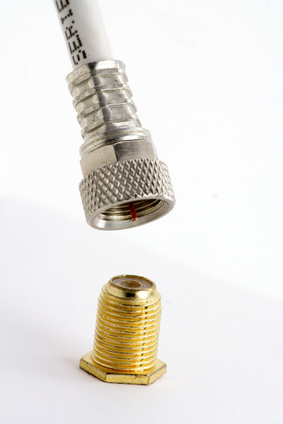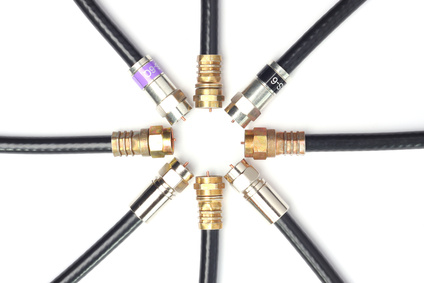Flexible vs. Semi Rigid vs. Rigid RF (Coax) Cable Assemblies

RF cable assemblies are made up of coaxial cable with appropriate connectors attached to the cable ends for interconnecting what are usually defined as signal sources and receivers. The Coaxial cables used are usually defined as flexible, the most common, semi-rigid and rigid with some hybrid cables such as “formable” cables that lie somewhere between flexible and semi-rigid and are usually applied to semi-rigid cable applications.
By definition a coaxial cable consists of an inner signal conductor that is surrounded by a tubular insulating layer (dielectric). A tubular conducting shield then surrounds these components. In this design the inner conductor follows the same geometric axis as the outer shield, or the inner and outer conductors are in a coaxial arrangement. Depending on the application a protective, non-conducting sheath is placed around the outer conductor.
Most commonly RF coaxial cables are used to form computer network (Internet and Ethernet) connections, distributing cable television signals or to connect RF transmitters and RF receivers with their antennas. When a voltage (signal) is applied to the center conductor and the shield is kept at ground (zero) potential, the design of the coaxial cable provides a transmission line where the electromagnetic field carrying the signal is limited to the insulated space (dielectric) between the inner conductor and the outer conductor or shield.
One simple advantage to this isolation is the allowance of installation of a coaxial line next to metal objects without power drainage. Additionally, the coaxial design provides protection of the RF signal from external RFI (radio frequency interference) or other EMI (electromagnetic interference). Consequently, coaxial cables are a good choice for weak signals that cannot tolerate interference and, conversely, for higher power transmissions that can cause interference to adjacent instrumentation.
Flexible Coaxial Cable

Probably the most common coaxial cable is the simple flexible coaxial cable commonly used by the layman to connect video equipment. This cable consists of a metal inner conductor, a flexible plastic polymer dielectric tube surrounding it, a braided/woven conducting metal shield around the dielectric and finally a jacket to protect the interior from environmental damage such as moisture, puncture and abrasion or breakage of the shield.
For extreme flexibility, a stranded copper central conductor is used with a surrounding dielectric tubing of PE (polyethylene) foam that is then surround by an Al tape outer conductor combined with a tinned copper braided shield.
When less flexibility is needed, somewhat higher performance characteristics are obtained when solid wire (bare copper, bare copper clad aluminum) or even copper tubing is used as the inner conductor. For higher frequency performance, the inner conductor may be silver-plated such as SPCW (silver plated copper wire) or silver plated copper clad steel. Braids and foils may also be silver-plated.
As an alternative to PE foam, more water resistant but less flexible solid polymer dialectrics such as LD PTFE (low density polytetraflouroethylene) are used. Cables can be jacketed with smoke retardent PE polymer coatings. The highest fire resistant rating is given to cable jacketed with FR PVC combined with PTFE dielectrics.
One of the disadvantages of highly fexible coaxial cable is the use of a braided shield that is not a smooth surface and bending causes variations in the actual electrical characteristics of the cable. Very sharp bends or even kinking of the shield can seriously affect transmission power and integrity. Similar results occur from bending of the stranded inner conductors. A solid conductor with a coating to smooth the surface and the use of a film shield within the braided shield are improvements but not ideal.
Semi-Rigid Coaxial Cable
To obtain better overall performance characteristics and dependability and maintain the concept of a coaxial cable designers have had to sacrifice flexibility. Semi-rigid designs provide better dielectric properties and shielding quality. Probably the most important difference between flexible and semi-rigid coaxial cable is that the braided outer or film shield is replaced with a solid metal outer sheath which has is bendable but flexible. Once formed (bent) the cable’s configuration is fixed.
Compared with a braided outer conductor, the solid shield provides superior performance especially at higher frequencies. In fact, the outer conductor can provide 100% RF shielding and allows precise spacing of the solid center conductor and surrounding dielectric. Outer sheaths can be solid bare copper, tin-plated copper or lighter (30%) tin-plated aluminum. Center conductors are commonly silver covered copper clad steel or SPCW. PTFE or LD PTFE tape is a common dielectric.
The semi rigid coaxial cable design providing the best electrical performance consists of a central conductor supported by a solid PTFE dielectric spline placed longitudinally inside a solid metal tube. These “Spline Cables” are fully vent-able and when mated to vented connectors they can be filled with air, other gases or operate in a vacuum as in spacecraft. They are expensive and require special care to bend and install. A copper tubular sheath lined with the dielectric PTFE/Air spline supporting a SPC tube center conductor is a common form.
Conformable or Hand-formable cables could be termed semi-flexible rigid-like cables and provide a choice when formation of the cable must be done at the point of installation. They can be cut, stripped and formed by hand. However, they are not intended for repeated bending. A solid tin plated aluminum shield, LD PTFE tape dielectric and a SPCW center conductor comprise a typical structure.
Rigid Coaxial Cable
Rigid coaxial cable is formed by two copper tubes supported at cable ends and at meter intervals with PTFE-supports and cannot be bent and require specially constructed elbows (45° and 90°) for turns/angles. Interconnections must be achieved with an inner bullet/inner support and a flange.
Rigid line coaxial cable is mainly used indoors for high power connections between RF-components in TV and FM broadcasting systems although the rigid line cables are used outdoors in antenna masts. Inner conductors are copper while outer conductors are either copper or aluminum for cost and weight savings.
Rigid vs. Semi Rigid vs. Flexible Coax (RF) Cable Assemblies
When outlining the benefits of rigid cable in comparison with semi-rigid or flexible coaxial cable it is in most ways a comparison between apples and oranges. Semi-rigid cables simply cannot come in the sizes necessary for high power applications involving TV, FM and many microwave frequency wireless transmission over significant distances. Semi-rigid cable sizes are limited for most applications to a 1/2” air filled spline semi-rigid cable with copper tube inner and outer conductors – a mini rigid cable – that is extremely difficult to bend are limited to GHz frequencies. Additionally, power-handling capabilities are measured at a few hundred watts.
Rigid cable comes in sizes ranging from 7/8” to 8 3/16”diameters, operate at TV and FM frequencies ranging from 800-60 MHz and have power capacities measured in 100s of KWs up to a megawatts and above. Sizes of 6 1/8” and above allow for multi-channel DTV/analog transmission. Elbows solve the problem of flexibility, and systems may be filled with dry air or inert atmospheres under positive pressure for outdoor use. Additionally, the newest designs do not require periodic maintenance and lifetimes are measured in decades.
When outlining the benefits of rigid cable in comparison with semi-rigid or flexible coaxial cable it is in most ways a comparison between apples and oranges. Semi-rigid cables simply cannot come in the sizes necessary for high power applications involving TV, FM and many microwave frequency wireless transmission over significant distances. Semi-rigid cable sizes are limited for most applications to a 1/2” air filled spline semi-rigid cable with copper tube inner and outer conductors – a mini rigid cable – that is extremely difficult to bend are limited to GHz frequencies. Additionally, power-handling capabilities are measured at a few hundred watts.
Rigid cable comes in sizes ranging from 7/8” to 8 3/16”diameters, operate at TV and FM frequencies ranging from 800-60 MHz and have power capacities measured in 100s of KWs up to a megawatts and above. Sizes of 6 1/8” and above allow for multi-channel DTV/analog transmission. Elbows solve the problem of flexibility, and systems may be filled with dry air or inert atmospheres under positive pressure for outdoor use. Additionally, the newest designs do not require periodic maintenance and lifetimes are measured in decades.